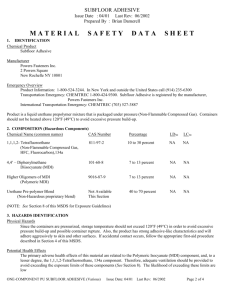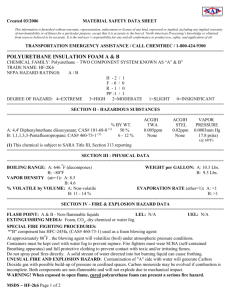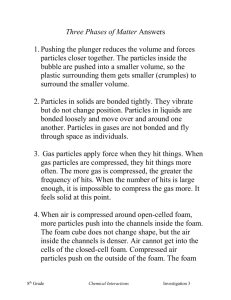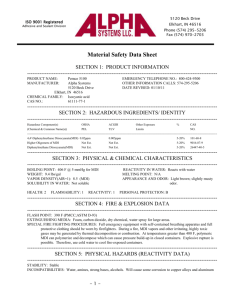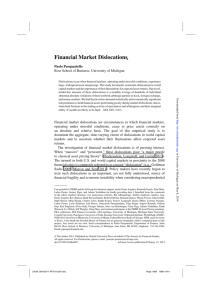Emergency Overview and Contacts
advertisement
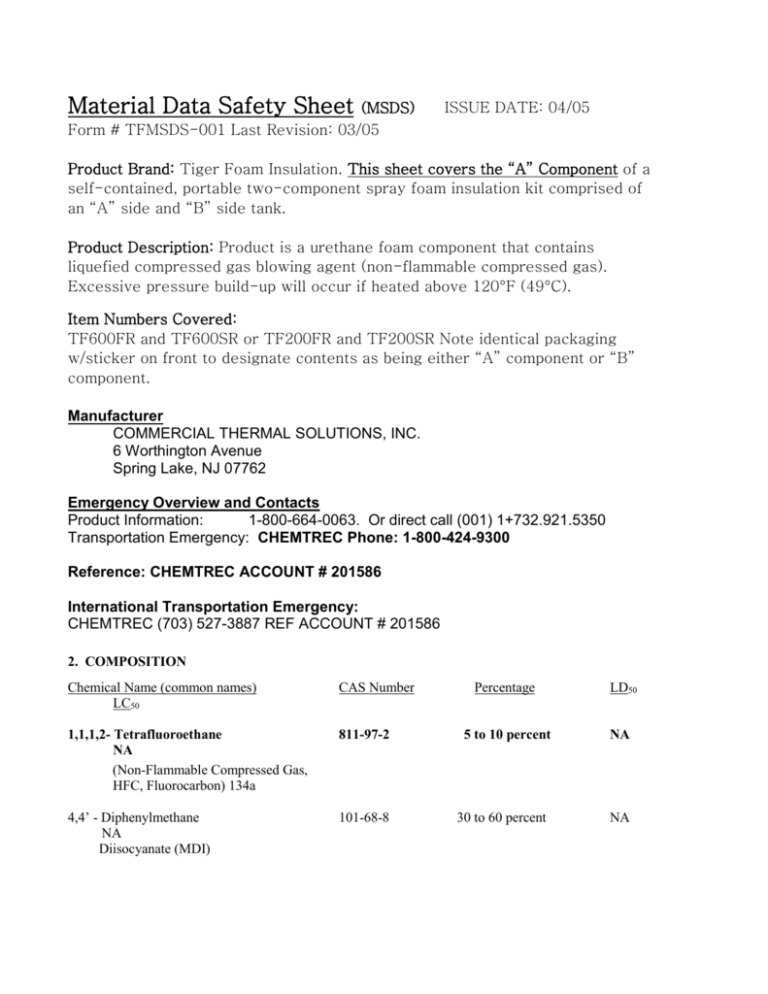
Material Data Safety Sheet (MSDS) Form # TFMSDS-001 Last Revision: 03/05 ISSUE DATE: 04/05 Product Brand: Tiger Foam Insulation. This sheet covers the “A” Component of a self-contained, portable two-component spray foam insulation kit comprised of an “A” side and “B” side tank. Product Description: Product is a urethane foam component that contains liquefied compressed gas blowing agent (non-flammable compressed gas). Excessive pressure build-up will occur if heated above 120°F (49°C). Item Numbers Covered: TF600FR and TF600SR or TF200FR and TF200SR Note identical packaging w/sticker on front to designate contents as being either “A” component or “B” component. Manufacturer COMMERCIAL THERMAL SOLUTIONS, INC. 6 Worthington Avenue Spring Lake, NJ 07762 Emergency Overview and Contacts Product Information: 1-800-664-0063. Or direct call (001) 1+732.921.5350 Transportation Emergency: CHEMTREC Phone: 1-800-424-9300 Reference: CHEMTREC ACCOUNT # 201586 International Transportation Emergency: CHEMTREC (703) 527-3887 REF ACCOUNT # 201586 2. COMPOSITION Chemical Name (common names) LC50 CAS Number 1,1,1,2- Tetrafluoroethane NA (Non-Flammable Compressed Gas, HFC, Fluorocarbon) 134a 811-97-2 4,4’ - Diphenylmethane NA Diisocyanate (MDI) 101-68-8 Percentage LD50 5 to 10 percent NA 30 to 60 percent NA Higher Oligomers of MDI NA (Polymeric MDI) 9016-87-9 30 to 60 percent NA (NOTE: See Section 8 of this MSDS for Exposure Guidelines) 3. HAZARDS IDENTIFICATION Physical Hazards Storage temperature should not exceed 120F (49C) in order to avoid excessive pressure build-up and possible release of contents. Also, MDI will react with water to form CO2 and water insoluble polyureas. This reaction may be vigorous at elevated temperatures, and could cause dangerous pressure build-up in tightly sealed containers. Liquid contents froth when released from containers. A-Component has strong adhesive characteristics. If accidental contact occurs, follow the appropriate first aid procedure described in Section 4 of this MSDS. Potential Health Effects The primary adverse health effects of this product are related to the Polymeric Isocyanate (MDI) component, and, to a lesser degree, the Fluorocarbon (134a) component. Therefore, adequate ventilation and respiratory protection should be provided to avoid exceeding exposure limits listed in Section 8 of this MSDS. Spraying MDI as a mist during application may increase vapor levels of this material. Entry Route: Effects of Overexposure Inhalation: May irritate mucous membranes with tightness in chest, coughing, or allergic asthma-like sensitivity. Extensive overexposure can lead to respiratory symptoms like bronchitis and pulmonary edema. These effects are usually reversible. Overexposure to 1,1,1,2 - Tetrafluoroethane may cause lightheadedness, headaches, or lethargy. Persons with cardiac arrhythmia may be at increased risk in severe exposure. Eyes: character. May be irritating to eyes. MDI contact can cause physical damage due to adhesive Skin: May cause localized irritation, reddening or swelling. Prolonged or repeated exposure may lead to sensitization and/or contact dermatitis. Ingestion: May cause irritation of mucous membranes in the mouth and digestive tract. 4. FIRST AID Inhalation: If breathing difficulty is experienced, move to area free of exposure. Provide fresh air. If necessary, provide oxygen or artificial respiration by trained personnel and obtain medical attention. Eye Contact: Flush with clean water for at least 15 minutes and obtain medical attention. Skin Contact: Use a rag to remove liquid from skin and remove contaminated clothing. Use of a solvent, such as acetone (nail polish remover) or mineral spirits, may help in removing uncured foam residue from clothing or other surfaces (avoid eye contact). May cause mild irritation or temporary darkening of skin. Persistent washing with soap and water will eventually remove all residue. If irritation persists, obtain medical attention. Ingestion: orally to an Drink 1 to 3 glasses of water and seek immediate medical attention. Never give anything unconscious person. . 5. FIRE FIGHTING MEASURES High temperatures will raise the pressure in the containers, which may lead to rupturing. Extinguishing media include: dry chemical, carbon dioxide, Halon 1211, chemical foam, or water spray if used in large quantities (water contamination will produce carbon dioxide). Wear self-contained breathing apparatus to protect against toxic decomposition by-products, including CO, CO2, NO, and traces of HCN. Cured foam is organic and, therefore, will burn in the presence of sufficient heat, oxygen and an ignition source. Main hazards associated with burning foam are similar to burning of other organic materials (wood, paper, cotton, etc.) and precautions against exposure should be taken accordingly. Avoid welding or other “hot work” in the vicinity of exposed cured foam. 6. ACCIDENTAL RELEASE MEASURES/DISPOSAL CONSIDERATIONS Wear skin, eye and respiratory protection. Soak up material with absorbent and shovel into chemical waste container. Loosely cover container and remove from work area. Decontaminate waste and spill area with a solution of 0.2 – 0.5% liquid detergent and 3 – 8% concentrated ammonium hydroxide in water (5 – 10% sodium bicarbonate may be substituted for ammonium hydroxide). Use 10 parts of solution for each part of the spill and allow to react for at least 10 minutes. Allow loosely covered container to stand for several days before disposing in accordance with all applicable federal, state and local regulations. Liquid residues may be mixed slowly with equal amounts of B-Component in a well ventilated area in order to form solid, low grade foam, which in most cases can be disposed of as a solid in normal waste streams. Never discard in a liquid state. Undamaged cylinders are returnable by following manufacturer’s instructions and all regulatory requirements. 7. HANDLING AND STORAGE Store in a cool, dry place. Ideal storage temperature is 60F to 80F (15.5C to 26.6C). Storage above 90F (32.2C) will shorten the shelf life. Protect unused product from freezing. Storage below 55F (12.7C) may affect foam quality if chemicals are not warmed to room temperature before using. Protect containers from physical abuse. 8. EXPOSURE CONTROLS/PERSONAL PROTECTION Read all product instructions before using. Personal protective equipment should include (impervious gloves, protective eye wear and suitable work clothes). Adequate ventilation should also be employed so that vapor levels do not exceed recommended guidelines. If vapor levels are expected to exceed these guidelines, use NIOSH approved, positive pressure, supplied air respirator or a negative pressure half mask with organic vapor cartridges and dust/mist pre-filters. Exercise good personal hygiene, wash thoroughly after each use. Exposure Guidelines OSHA ACGIH 4,4’ – Diphenylmethane ppm TWA Diisocyanate (MDI) mg/m3 TWA .020 ppm ceiling .005 .200 mg/m3 ceiling .051 Higher Oligomers of MDI Established None Established None 1,1,1,2 - Tetrafluoroethane (Non-Flammable Established Compressed Gas, HFC Fluorocarbon 134a) None Established None (None of the components in this product are listed by IARC, NTP, OSHA or ACGIH as a carcinogen). 9. PHYSICAL AND CHEMICAL PROPERTIES Physical Appearance when released from : Amber to dark brown liquid. Froths to an off white to yellowish color container. (Note; Appearance may differ with the introduction of a dye or colorant). Odor : Slight musty odor Specific Gravity : Approximately 1.2 (H2O = 1) Boiling Point Fluorocarbon 134a) : 1,1,1,2 - Tetrafluoroethane (Non-Flammable Compressed Gas, HFC boils at -15F (-26C). MDI boils at 406F (208C). Flash Point : 1,1,1,2 - Tetrafluoroethane (HFC 134a); none. MDI; 390F (199C). Vapor Pressure kPa. For MDI : Contents under pressure have vapor pressure greater than 50 psig/345 liquid less than 10 mm Hg at 77F (25C). Solubility in Water : Insoluble, reacts slowly with water to liberating traces of CO2. Explosion Data discharge. : Contents are not known to be sensitive to mechanical impact or static 10. STABILITY AND REACTIVITY This product is considered stable under normal and anticipated storage and handling conditions. Do not store above 120F (49C). For longest shelf life, avoid storage above 90F (32.2C). Avoid alcohols, strong bases or amines and metal compounds (such as small particle metal catalysts). Avoid contamination with water. 11. TRANSPORTATION Shipping Information Ground Containers Less Than 1000 cu. cm. (1 liter) Consumer Commodity ORM-D (On Shipper Carton) Consumer Commodity Two-Component AComponent (On Shipping Document) Containers Greater Than 1000 cu. cm. (1 liter) UN1956 Compressed Gas n.o.s. (Fluorocarbon) 2.2 (Non-Flammable Gas Label) Air UN 1950 Aerosols, Non-Flammable 2.2 (Non-flammable Gas Label) UN1956 Compressed Gas n.o.s. (Fluorocarbon) 2.2 (Non-flammable Gas Label) Water UN1950 AEROSOLS , (Limited Quantity) Class 2 UN1956 COMPRESSED GAS N.O.S (Fluorocarbon) 2.2 Exceptions N/A Note Emergency Response Guide Numbers - Consumer Commodity # 171. For Aerosols and Compressed Gas # 126. 12. REGULATORY Toxic Substances Control Act (TSCA)/Domestic Substances List (DSL): All ingredients are listed on the TSCA inventory, as well as the Canadian Domestic Substances List. SARA Title III: Contains Diphenylmethane Diisocyanate (CAS #101-68-8) which is subject to the reporting requirements of SARA Title III. Applicability must be determined by end user. Proposition 65: Based on information currently available, this product is not known to contain detectable amounts of any chemicals currently listed under California Proposition 65. V.O.C. Content: Based on the current EPA definition of volatile organic compound, this product does not have any V.O.C. content. 13. OTHER NFPA: HMIS: Fire 1; Health 3; Reactivity 1 Flammability 1; Health 3: Reactivity 1 The information and recommendations set forth herein are presented in good faith and believed to be correct as of the date hereof. The manufacturer makes no representations as to the completeness or accuracy thereof. Information is supplied upon the condition that the persons receiving it will make their own determination as to its suitability for their purposes prior to use. In no event will the manufacturer be responsible for damages of any nature whatsoever resulting from the use of or reliance upon information. No representations or warranties, either expressed or implied, of merchantability or fitness for a particular use are made hereunder with respect to this information or the product to which information refers. Information contained herein is deemed to be reliable, conservative and accurate. Commercial Thermal Solutions, Inc. reserves the right to change the design, specifications or any other features at any time and without notice, while otherwise maintaining regulatory compliance. LAST REVISION : 03/05-01 APPROVED BY : P. Pinata TFMSDS001
